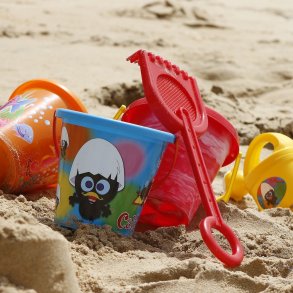Assembled & edited by Jane Allen and Nick Owen, originally published in Integral Leadership Review
Snapshots of a transformational leadership conference with inputs from Bill Torbert & Frederic Laloux
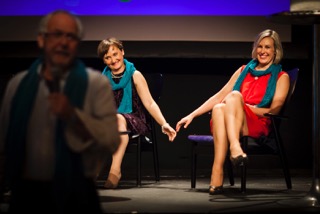
Heidi Gutekunst (Finland), Irena Pranskeviciute (Lithuania), Nick Owen (UK)
Amara is a collaboration of likeminded leadership practitioners formed earlier this year with the stated purpose of doubling the number of leaders with transformational leadership capacity worldwide within 25 years. The founders are Heidi Gutekunst (Finland), Irena Pranskeviciute (Lithuania), Jane Allen (UK), and Bill Torbert (USA). The Amara Collaboration, as it is formally known, already has several international workshops under its belt and more in the pipeline (see www.amara.fi). This article is a collaborative report on a conference and workshop, The Amara Adventure, which took place in Helsinki during a weekend in September 2015.
Amara co-founder Jane Allen on the thinking behind the event:
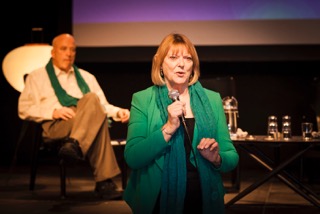
Bill Torbert and Jane Allen
We planned a 1-day workshop followed by a half day ‘deeper dive’. The idea for the weekend was born almost six months previously and after the initial planning the workshop team worked and lived together for the final two weeks even though the four of us live in different countries and indeed on different continents!
Of course our intention for the Amara Adventure concerned the events themselves, but more importantly it was about demonstrating our beliefs and practices, about wanting to offer a culture for learning and organisational life with the purpose of changing the nature of engagement. We labeled the events ‘adventure’ to capture the spirit of risk that comes with challenging our own and others’ assumptions, perceptions, and perspectives and to reflect the surprises and thrills that can accompany such journeys.
Part of that adventure is the tricky enterprise of putting together a large open international event and engaging with a potential audience and with sponsors.
Here’s Amara co-founder Heidi Gutekunst:
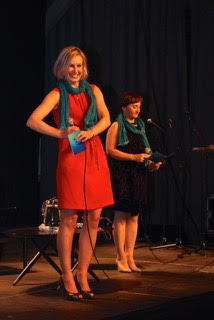
Heide Gutekunst
Setting up a branded conference for one hundred people, with no prior event production experience, was in itself an adventure. It was a dance and stretch between working hard for it to be perfect and just letting things fall into place. We were focusing on sales and the next moment on producing note books or attracting partners and felt very lucky when we realised transformational leadership and reinventing organizations was a juicy topic for the media. I felt like I was stepping into the unknown every step of the way, but did so mostly with childlike excitement and inspiration, but at times also with anxiety.
The co-founders of Amara are themselves a collaboration of individuals with very different personalities, backgrounds and qualities joined together around a compelling vision for aware leadership and an enduring commitment to living their values. They walk their own path of challenge, risk and companionship as well as offering to partner with others towards the same vision.
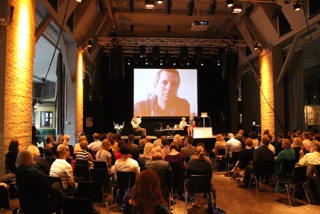
Frederic Laloux onscreen
It was in this spirit of collaboration that Frederic Laloux was invited to make a contribution by video link to the Adventure. The core of his recent book Reinventing Organizations is all about the emergence of a new organizational model, a model inspired by the successes of a small but growing number of significant companies that have embraced post-conventional values and transformed how they do business.
The evolutionary values of these companies he labels ‘Teal’ using the colour scheme used by Ken Wilber and derived from Spiral Dynamics. Frederic’s work, drawing on various models of development psychology such as those of Kegan, Barrett, Graves et al., has a strong resonance with Bill Torbert’s work with action logics (stages of development), the Global Leadership Profile, and post-conventional leadership strategies. The on-stage, real time, dialogue between Frederic in Belgium and Amara co-founders Bill and Heidi in Helsinki was a central element of the Adventure’s exploration.
Jane continues,
In addition to collaborating with provocative thinkers like Frederic, we also wanted to extend outwards towards a group of practitioners who we know practice elements of the transformational leadership that we promote. These practitioners were invited to join us even though they might not necessarily be aware of their transformational practice or be able to articulate it clearly. We see in them people who are running organisations or leading within large companies and who possess an amazing transformational and collaborative intent. So these practitioners were invited as co-inquirers who would join us, contribute to each other’s experience, and offer some of their practice and inquiry to the conference’s paying participants.
Here are the comments and reflections of three of them. First,
Catherine Holland, CEO of a UK based Community Rehabilitation Company:
My colleague and I were welcomed warmly and within minutes we were drawn effortlessly into a relaxed conversation with other participants about ‘what we wanted to know about transformation’, our thoughts captured on a nearby flip-chart. ‘What time does it start?’ asked my colleague ‘I think it already has’ I replied. This set the tone for a well crafted couple of days mixing structured and unstructured sessions, plenary and group explorations, action inquiry approaches and a few slightly off the wall (but fun and enlightening) exercises to explore transformation, both personal and organisational, leadership and post conventional ideas. By the time we sat down for the formal introductions there was already a rich collection of questions to explore.
Being invited to attend as an ‘expert practitioner’ was both flattering and frightening and I was not at all sure about what I was going to add, but the easy way in which all participants were invited to contribute on an equal basis meant that I was able to add my thoughts and experiences in a natural and spontaneous way. I was rewarded by some excellent insights from my fellow participants and the Amara founders and volunteers, enhanced by international participation. In addition to being able to bring home some great ideas, I made some valuable connections with some amazing people.
Tricia King is in a transition space having recently left Birkbeck College at the University of London where she was Pro-Vice-Master Strategic Engagement and Director of External Relations:
When I set off to the Amara event I was much pre-occupied with the new job I would be starting in the following weeks. After an eleven-year love affair with a unique and truly magnificent UK university, I was off in search of a new adventure and my head was full of new beginnings. However, it was the deep enquiry I was able to have with colleagues at Amara that revealed to me just how important it was to leave well and how, at the point of departure, there was real opportunity to speak truths and land important messages.
I started to plan my leaving speech that I would give in front of 200 influential people to say more than just goodbye. The importance of story became the key theme. Stories have always pre-occupied me. In the world of higher education, where league tables matter and we are required to measure everything, I believe stories can help us notice other, deeper truths. They help us understand and navigate complexity with confidence. They give us clarity around identity and purpose as well as help us hold dear and defend that for which there is no metric. I practiced hard and delivered the speech without notes. I know the ideas resonated. I know people heard. Without the time with Amara in Helsinki, that critical opportunity to name and influence would have been lost or wasted.
Nick Owen is a leadership coach, catalyst, and storyteller. This is his perspective:
I was invited to attend both as a Practitioner and as part of the hosting team. My contribution in support of the programme was to get participants on the floor: sharing stories, learning to deeply listen to one another, and being playful with their interactions through the lenses of first, second and third person perspectives. My own sense of nervousness and excitement stemmed from the emerging nature of the programme which was refining itself right up to kick off (and beyond) and the usual unknowns about how much would the participants want to play. Could they be persuaded to overcome their natural Nordic reticence?
Of course they could! Their stories explored moments of professional success and failure; followed by a round of stories in a larger group sharing experiences of personal or professional transformation. Later in the day we worked with silence and emergence, finally improvising a whole group experience that engaged all the participants in interaction with our context, the splendid vaulted brickwork of our venue, Helsinki’s old municipal Tramshed.
During the second day’s Deeper Dive we explored leadership, followership, and the power of mutually sensitive collaborations through visual metaphors and improvisations, ending the day with a physical tableau, working only with our bodies, to sculpt out what the future of transformational (or Teal) leadership might look like and feel like for us. Wacky and sometimes puzzling to some, the very act of committing to simultaneous action with inquiry demonstrated that it takes just one step to begin a process of change.’
Jane continues:
The next step of cooperation was bringing together a group of ‘volunteers’, local people familiar with Amara’s work, aims, and intentions who joined us to help create a great experience for participants and visitors. A dozen or so of them welcomed arrivals and then recorded the whole experience in a variety of different ways whilst co-inquiring and participating at the same time.
This is Janne J Korhonen, one of the volunteers and an organizational consultant, on his Amara experience:
Amara Adventure was “well self-organized.” Little did I know how little effort there would be as I volunteered to help with the logistics and organization of the day. There were just the right number of helping hands, just at the right place and the right time. Breeze, flow, synchrony. Everything fell into place as if each movement, each action, and each gesture was thoughtfully choreographed and carefully conducted, yet it was the exact opposite: no-one knew what would happen next, no-one could foresee how things would play out. Nonetheless, I felt I was important; that all of us were important, useful, respected.
The structures were requisite: everyone knew their role and general responsibilities, and broad-stroked policies and simple rules governed how we – the volunteers who had never before worked together – enabled a smooth event experience for the participants. These structures were like a riverbank: allowing the flow. And we flowed. We streamed, and the stream pulled us along, and it pulled everyone to the adventure.
The theme of the day was organizational transformation. Hardly a foreign concept for me, I thought, having studied the subject intensively in my dissertation research. And yet, I was taken by surprise in the way transformation was incarnated throughout the day – embodied in the form of “felt sense” experience, reminding me of the intrinsically and inexorably ‘human’ nature of organization and its transformation. This would unlikely have been possible without the “open space” setting that “opened space” for emergence of deep collective inquiry: hues and cues of what the shared exploration of the transformation journey in human organizations entails. The skillfully facilitated sessions conveyed concrete inklings of how transformation actually feels. Such a powerful takeaway would be unimaginable in a traditional conference setting. Amara Adventure, by contrast, got me on a natural high: touched, enthralled, excited.
The Adventure was not without its flaws and human vulnerabilities. A few people were seen texting and answering e-mails, and others reported dissatisfaction with the devolved nature and inevitable messiness of the Open Space process. (The desire to hang on to the illusion of control dies hard). One excellent piece of feedback was that having a couple of the delegates on stage to join the discussion about reinventing organisations between Frederic, Bill and Heidi would have made the session more dynamic, more rooted in the realities of regional leadership, and more likely to dispel notions that we need to wait for the ‘gurus’ to change our organizational cultures.
One of our Practitioners, Ute Bock a risk consultant working in Switzerland, offered some excellent critical insights into the two days, particularly around how she and some of her co-participants were responding:
What is Amara providing, what does it want people to learn, and how will it create a platform that can ignite change and mid- to long-term transformation? Some steps were made at the conference that allowed a first taste, moments of “ignition” for some of the people I spoke to. But was it enough?
Questions that I heard raised during the group work and breaks included the following dilemmas and challenges: Yes I’d like to see myself as an enabler but my environment doesn’t allow ‘vulnerability.’ ‘Each step I take is judged without anyone looking at where we are heading.’ ‘No one except me sees the space behind the mountain.’
From the conversations that followed a series of questions emerged:
How do we explore ourselves? How do we discover wholeness?
How can we create safe spaces that encourage the mistakes that are necessary for learning?
How can we embody our vulnerability, fear, or loneliness while still remaining present to ourselves and to our organization?
How do we explore what it means for oneself and the organization to share ‘control’, collaborate more, and develop mutual leadership?
I noticed that some participants were focused on finding the ‘quick fix’ while others were searching for ways to implement the ‘how tos’ and deeper challenges. Some maybe felt overwhelmed by the notion that one has to start with oneself. Trans-formational leadership certainly seems to be a journey that many are afraid to take up.
During the conference itself the mix of presentation, open space, action, and focusing worked well until mid afternoon and then faded a bit. Whether this was a design issue or the consequence of the national transport strike taking place that day and people worrying about getting home was not completely clear. Overall the process did raise a lot of curiosity and questions such as ‘Where do I take this now?’ ‘What’s my first step?’ ‘What do I need to do next?’
I especially welcomed Part Two of the programme, the ‘Deeper Dive’, and wished it had been possible to get more people involved in it. In particular it would have created a safe space for participants to explore their own and their organisations’ openness to transformation. Certainly the collaborative fishbowl process, which Jane applied to great effect on the second morning, seemed to help three colleagues from the leadership team of one Finnish company appreciate where they were currently stuck and what other options might be open to them. Maybe this wider participation is something to be considered for next year’s conference.
There were two other key groups of people at the event: the partner organisations and the participants. The partners’ greatest contribution was to bring people from their own organisations and networks to the conference. They had their own clear intentions for supporting the event having experienced Amara’s work previously in either personal or professional capacities. They perceived the value of this initiative and they participated fully and directly in many different ways. One of the most significant of these ways was the intention to introduce colleagues within their own organisations to transformational ideas and strategies so as to expose them to new ideas and provocations for their own change process. It is hoped that the learning and feedback they took away from the programme over the two days about themselves and their colleagues was a worthwhile gift for their generosity in backing ands supporting the event.
Kaija Pohjala is the Managing Partner of Cocomms, one of Finland’s leading PR consultancies, and was a Founding Partner of the Amara Adventure:
We decided to partner this event because we see a clear need for transformational leadership among our clients. We also want to develop our own services in this field for our customers. Leadership is all about communication, and leaders need to model for their people how to think, act and work in ever changing environments.
I wanted my managers to participate and learn about new kinds of leadership. We even invited some of our clients. The value of it was many-folded. For example, the Deeper Dive on the second day really taught me about shoemakers’ children that don’t have any shoes!! I learnt about my own vulnerability and the need for me to express myself more openly to my management team.
As a management group we need to start from internal communications if we really want to develop leadership in our company and turn it into a true ‘Teal’ organisation. We also got some useful additions to our toolbox to develop our services for clients who are going through various change processes. The event truly showed me that the time is right and people are ready to take the next, necessary and sometimes frightening steps forward into transformational or conscious leadership.
The participants, or ‘visitors’, attended for a wide range of reasons. Here are some of their differing perspectives that illustrate the richness and diversity they brought and which served to remind the organisers not to make assumptions or reduce the participants’ feedback to some simple story that might prevent them learning from their direct experience of the event.
On the whole the feedback was very balanced between positive affirmation and honest critique. Participants’ comments on the positive aspects of the day included:
I learned such a lot both from the models and the conversation.
I’ve been speaking about it at the office spreading the inspiration
It was organic. The Open Space sessions led to an interaction that usually isn’t there in these kinds of events.
Valuable critical feedback, particularly around the areas of grounding, framing, and finessing the Open Space, included:
Bill, Frederic and Heidi’s presentation was super interesting, but sometimes hard to follow. A fuller introduction would have helped me to understand more.
A poor experience to watch a video that you can watch online, in a conference. (Jane adds: In fact, the video was specifically prepared for the Conference and available on our website. We simply omitted to make that explicit at the Conference. Doh!)
There were several suggestions about improving the Open Space:
- It was difficult for others than practitioners to bring topics
- It functions better if there is no facilitator, even though it might need someone to explain it in the beginning and some groups were too big.
As for the Hosting Team, the four co-founders each had their own individual intentions, hopes, and questions about the theme and the role of Amara.
Jane:
Collectively, we were keen to demonstrate how much we value the centrality of collaboration as we co-created the experience. We held an aspiration that the event might offer a felt experience of transformational leadership and the invitation for engaged ‘organisations’ to reflect on new ways of being as well as doing.
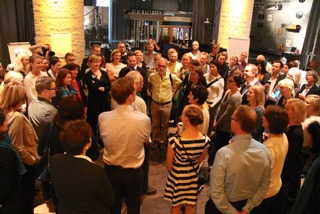
Listening
My own personal inquiry throughout the process was about how the four of us developed mutual power and inter-independence across different territories: the masculine & feminine, different generations, four cultures, and our own yin and yang. I found myself moving between being fully in the limelight (which at times made me feel vulnerable and self conscious) and being fully integrated into the experience. For example, on the second day I felt no boundary between myself and the experience we were all sharing. The different roles we were playing the day before seemed to dissolve as if we were now in a new and special group that had some lightness and a much more playful structure. It became totally self-organising and in that flow we experienced a new level of being as a collective beyond our expectations and our usual day to day experiences.
I had led the design of both days yet once the event began I simply had to let it go; let others take up the baton so that it all could happen. Letting go launched me on a roller coaster of pride, fear, frustration, joy, tiredness, and energy … and at the end a delight that we had all taken part in a collaborative adventure. The questions that reverberate for me now are: how do we translate this small happening into the wider world? How do we breathe inspiration into organisational life? How do we nuance a more delicate and discerning appreciation of leadership?
Heidi concludes:
Amara Adventure served its purpose as a launch event in Finland and as a first opening for a wider conversation about transformational and aware leadership and new, more sophisticated ways of organising. We were pleased with not only having early adopters but mostly leaders and management teams from a number of industries. The energy level was high for most of the two days and I was pleased seeing people connect on a deeper level than they are used to in conferences.
I have to say that our volunteer team’s performance was extraordinary. They made a wonderful contribution to creating a warm and welcoming environment for everyone. In the future I see many more Amara Adventure conferences happening in different parts of the world. We will learn from our mistakes, improve the concept, and make sure we have partners helping with those elements where we lack expertise. Stay tuned for more!
Featured Image/Graphic link added by Enlivening Edge Magazine


